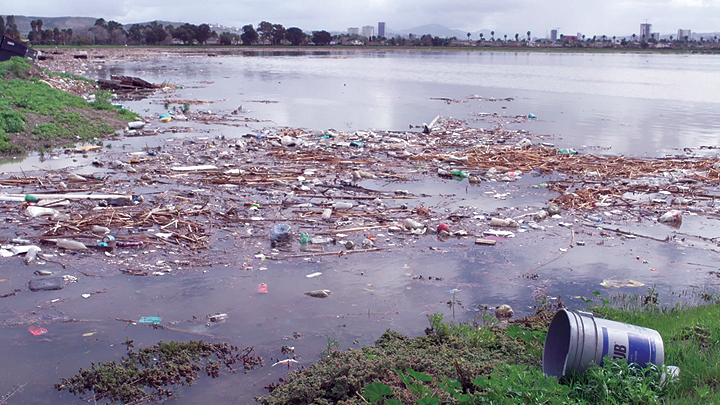New report: Public health crisis unfolds as Tijuana River sewage contamination escalates
The new report by SDSU researchers shows that the public health impact may extend far further than beach closures, as toxic chemicals and microbes are also found in air and soil.

A new report released by San Diego State University’s (SDSU) School of Public Health researchers finds an escalating public health crisis due to Tijuana River contamination flowing from Mexico into South San Diego.
This new paper, commissioned by Prebys Foundation at the request of Congressmember Scott Peters, brings to light how toxic chemicals and microbes in raw untreated sewage, industrial waste, and urban run-off, once thought to remain isolated to just the water, can also be airborne and linger in soils, which may have much larger and farther reaching environmental health impacts.
As part of the paper, researchers reviewed over 60 related studies and reports, examining environmental and public health concerns in the Tijuana River Valley and Estuary.
The International Boundary and Water Commission has reported that over 100 billion gallons of untreated sewage, industrial waste, and urban runoff have spilled into the Tijuana Estuary and the Pacific Ocean via the Tijuana River and its tributaries over the last five years.
“This environmental catastrophe has hurt the region for many years, resulting in decades of adverse health consequences,” Peters said. “We must approach it as a health and national security concern, which is why I asked the Prebys Foundation to help me build the case that this crisis goes far beyond beach closures; the people of South Bay now endure constant toxic air pollution that damages their health and well-being.”
This ongoing contamination has resulted in over 700 consecutive days of beach closures, significantly impacting local residents, visitors, and economies. In addition, lifeguards, U.S. Navy personnel, first responders, and border patrol agents face dangerous occupational health exposures.
The risk of acute infectious diseases and chronic conditions are potentially high but are not well understood, indicating a public health crisis with the possibility for long-term impacts on health, society, and the economy.
According to the SDSU report, the pollution is not only highly toxic, affecting water, air, and soil, but also poses health risks to vulnerable groups such as children, seniors, outdoor workers, and special populations including pregnant women. Antibiotic-resistant bacteria and other serious pathogens of public health concern, previously thought to be eradicated in California, have been found in the polluted waters.
The alarming discovery prompted SDSU researchers to call for further investigations to better understand the public health exposure risk in the impacted communities.
The report also states that climate change and more intense storm events could exacerbate these issues and further degrade the area infrastructure.
“There needs to be more research done to fully understand the extent of the risks posed by exposure to these dangerous contaminants,” said Paula Stigler Granados, associate professor in SDSU’s School of Public Health and the paper’s lead author. “Urgent interventions are needed to help reduce and address both the immediate and long-term potential health repercussions to those living near this hazardous environment.”
Imperial Beach Mayor Paloma Aguirre has been calling for the involvement of San Diego County, the California Department of Health (CDPH) and Centers for Disease Control and Prevention (CDC) to actively monitor the issue and public health concerns related to transboundary sewage. In recent months, Aguirre has formed a task force in collaboration with SDSU’s School of Public Health and the University of California, San Diego School of Medicine.
"The persistent health impacts greatly reduce the quality of life for the community,” said Aguirre. “It's a challenging task, but now is the moment to ensure that our elderly, our children, and water enthusiasts are not exposed to heightened health hazards while simply trying to enjoy a sunny day. Tackling this problem promptly and effectively is essential, as it is closely linked to the health and well-being of South Bay communities. The residents of Imperial Beach are worthy of far more than what they have been handed down.”
The researchers say the problem is an environmental justice issue as well, as border communities, often with limited economic resources, already have an increased risk of chronic diseases, which could put them at higher risk of complications due to these environmental hazards.
These communities also already face increased pollution from other sources, such as from the vehicles idling at border crossings. These border communities have lost access to healthy outdoor spaces. It’s not only impossible to access the beach and ocean during pollution events, but some of the toxic waste could be airborne and affect people within the communities.
“This study confirms what should be obvious, which is that San Diego’s health and community well-being are being seriously and actively harmed by years of inaction on this issue,” said Prebys Foundation CEO Grant Oliphant.
“The good news is that it is fixable, and that leaders like Representative Peters and Mayor Aguirre and organizations like SDSU’s School of Public Health are working to make that happen,” said Oliphant. “Their efforts deserve broad support, because public health in our region depends on a robust shared commitment to protecting everyone in every one of our communities from these sorts of preventable harms.”



